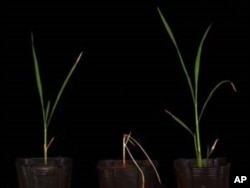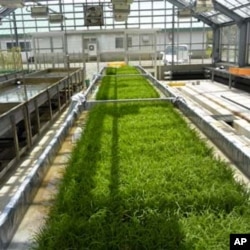Scientists are developing a salt-resistant variety of rice.
The move was prompted, in part, by last year's Japan tsunami, which flooded some 20,000 hectares of rice paddies.
The rice varieties Japanese farmers were growing in those paddies couldn't survive in salt-contaminated soil.
Those ruined paddies might be the first to test out the new rice-growing techniques.
Delicate balance
The challenge before scientists, says plant biologist Sophien Kamoun at the Sainsbury Laboratory in the United Kingdom, is, “How do you introduce a new trait like salt tolerance into that local variety, while at the same time you maintain all the other traits that make that variety really ideal for that region?”
Plant breeders normally take that ideal variety and mate, or cross, it with one that is salt-tolerant. Some of the offspring would acquire that trait. But they may also differ from the ideal variety in other ways.
“If you make a cross, for example, with an unrelated variety of rice, you will have thousands of differences," Kamoun says.
Those differences may be good or bad. Accentuating the positive while eliminating the negative may take a decade or more.
Kamoun and colleagues in Japan started instead with a popular high-quality rice variety and, using a technique common in plant breeding, introduced random changes - or mutations - in the plant’s genes with a chemical.
“Then you end up with thousands of plants that have all kinds of changes in their habits," Kamoun says. "And then you plant them out there in the field and identify the plants that have particular traits of interest.”
Sequencing lots of genomes
Then Kamoun’s group did something that would have been too difficult and expensive just a few years ago. They used new technology to sequence the entire genomes of the plants with those traits of interest. They identified precisely what genetic changes were found in plants with the new traits and where those changes appear on the map of the rice genome.
It’s a big improvement for crop breeders who usually follow rough landmarks in the genetic map to guide their efforts.
“Instead of saying, ‘It’s between Street A and Street B,’ you can say, ‘It’s exactly this address,’” says U.S. Department of Agriculture scientist Shannon Pinson.
She was not involved in the research. But she says it is exciting not only because it makes plant breeding more precise. She says even when breeders know where in the genetic map to find the genes responsible for a trait, or phenotype, “That doesn’t mean we know exactly what the gene is, and what the sequence is and what change in that sequence is causing that change in phenotype.”
Pinson says the new method hones in on the precise changes in a gene responsible for changes in a trait. That should make it easier to figure out how the gene works.
Sophien Kamoun says his colleagues have already improved the salt tolerance of a high-quality rice variety in greenhouse experiments and expect to have it ready for farmers in a couple years - far sooner than conventional breeding would take.
And he says the methods should cut the time needed to develop other varieties and other crops as well.












